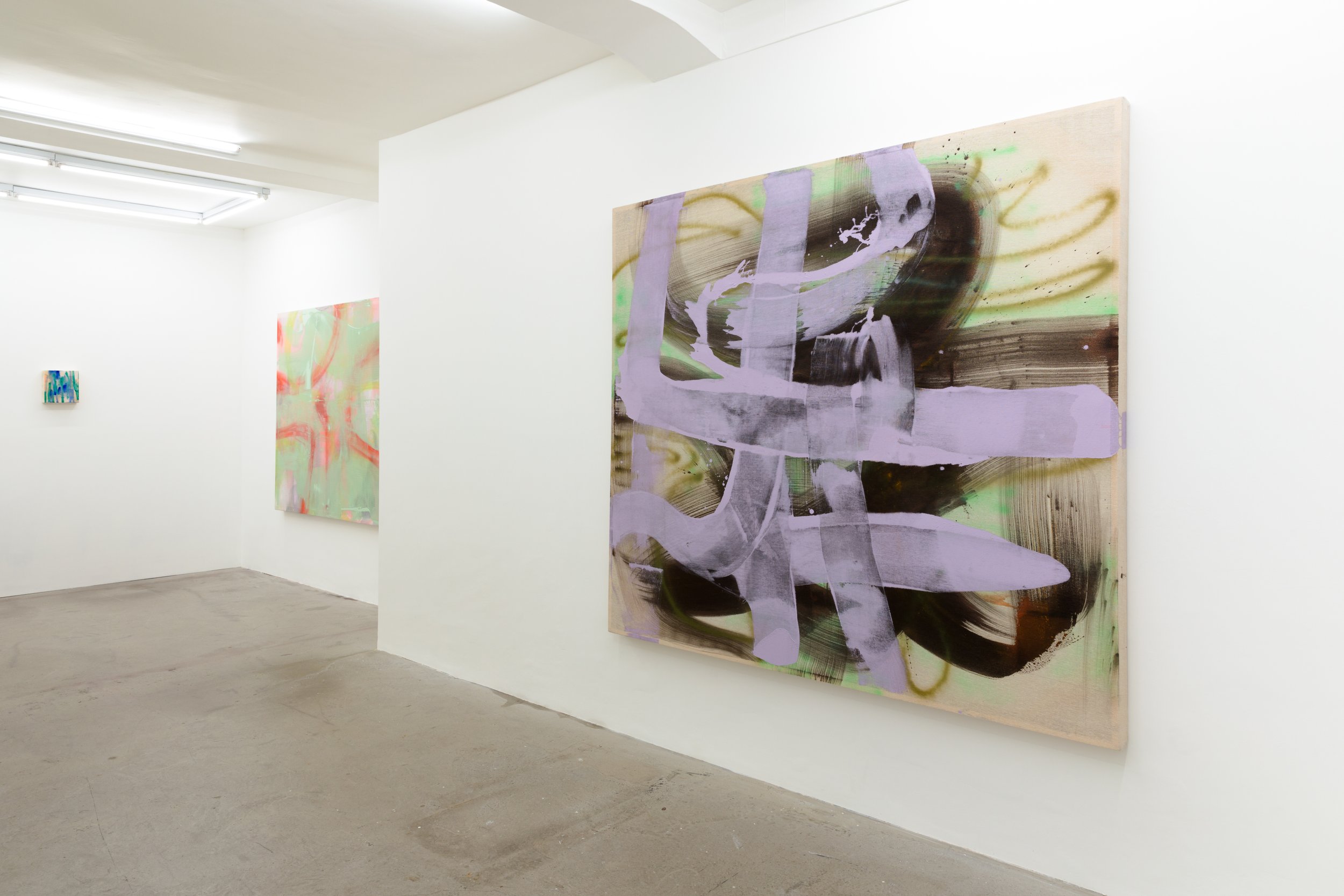Hettie Judah on Betsy Bradley
Installation view, Vardaxoglou, London, 2022
Read Hettie Judah’s extended text for Betsy Bradley’s solo exhibition at Vardaxoglou. Hettie Judah is senior art critic for British daily newspaper The i.
–––Talk to Betsy Bradley about her work, and she gently withdraws herself from the act of creation: ‘I have to give credit to the tools here’, she’ll say. She’ll note how surprised she was by the marks they made. She’ll tell you she re-used a painted piece of wood just as it was when she found it. She chose to work on a dustsheet rather than canvas because it was available. She liked how the knots in a rejected length of timber recalled the tree it once was. She enjoyed the chance way paint passed through muslin onto the wooden stretcher behind it.
In Bradley’s world view, materials act – they are vibrant, lively, potent. Here painting is not a matter of mastery and domination. Instead, it comes closer to a controlled experiment: decisions are made that precipitate a sequence of events in which chance, instinct, and the properties of materials are allowed full expression. Asked about colour, Bradley will describe herself reacting, rather than imposing – responding to one tone with another that surprises her, then another, then another – to achieve teetering harmony, as though she were making visible a pre-existing state of equilibrium. She is interested in how painting can make the intangible visible: brushstrokes that give form to an exhalation, to energy, to gesture, to euphoria, to balance.
Installation view, Vardaxoglou, London, 2022
The swoops and dives, traces, floods, scrapes, whispers and slicks of paint we find here are the result of improvised choreography: a series of pas des deux between Bradley and her homemade brushes and tools. Those tools can be marvellously, comically unwieldy: handles made from fenceposts, with pasting brushes lashed together at the end. Bristled draft excluders ripped from the bottoms of doors. The marks they make are unpredictable, as is the range of movement available to Bradley as she paints. She first experimented with gestural abstraction, painting with brooms among other things, during her foundation course in Bath, but set the practice aside for many years until an exhibition in the Coventry Evening Telegraph building in 2017, while on her MA course at the University of Birmingham. Making tools from the materials to hand (draft excluders included) became a way to integrate her work more deeply into the architecture: here was a painting that engaged not only with the surface and spaces of the building, but with its fabric.
In a recent exhibition at IKON in Birmingham, Bradley responded to, and played with, the architecture in different ways. She replaced a partition wall with a painted voile screen – her gestural marks seemed to float in the air, animated by visitors moving in the space beyond. Other works, on voile and fine muslin, exposed their inner structure and detail of the supporting wall. A small canvas was suspended horizontally on long ropes, as though the seat of a rough wooden swing. Another was slung over a trapeze. In imagining how we might experience painting in fresh ways, Bradley looked to the irreverent, mobile modes of presentation deployed by Vivian Suter and Alexis Teplin.
Installation view, Ikon Gallery, Birmingham, 2022. Photo: Stuart Whipps
At IKON, two dancers were invited to respond to the works, including a painting on a piece of loose cloth that was available to crumple, drag, and roll around in. As if to say: well, what is a painting after all but a bit of paint on a bit of fabric? Or not even that – there was also coloured sand, first arranged by Bradley, then rearranged by visitors’ feet – a gesture of humility and impermanence that recalls the sand mandalas of Tibetan Buddhism.
This is not entirely coincidental. Bradley’s work is not spiritual as we might commonly understand the term, but her philosophical engagement with Buddhism manifests in aspects of her painting practice: her interest in the intangible, and the impermanent, the way she plays with tension and balance in the different intensities of her marks as well as in her use of colour. As in Japanese calligraphy, you need a clear head to achieve the lightness of ‘one shot’ works like this.
‘Playful’ is a word Bradley uses often in speaking of her work, her modes of presentation, and her engagement with surrounding architecture. When I write of lightness in her work, I mean it not in the sense of something inconsequential, more as this playful way of being in the world. Restrained in materials, economic in gesture, considered in her use of colour: where she wishes it to, Bradley’s painting appears to float free of its supports, though it can also be honestly material, and grounded.
Hettie Judah


